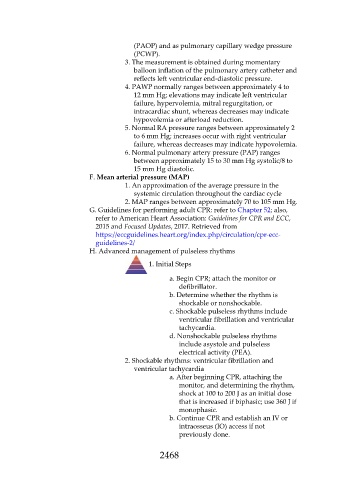Page 2468 - Saunders Comprehensive Review For NCLEX-RN
P. 2468
(PAOP) and as pulmonary capillary wedge pressure
(PCWP).
3. The measurement is obtained during momentary
balloon inflation of the pulmonary artery catheter and
reflects left ventricular end-diastolic pressure.
4. PAWP normally ranges between approximately 4 to
12 mm Hg; elevations may indicate left ventricular
failure, hypervolemia, mitral regurgitation, or
intracardiac shunt, whereas decreases may indicate
hypovolemia or afterload reduction.
5. Normal RA pressure ranges between approximately 2
to 6 mm Hg; increases occur with right ventricular
failure, whereas decreases may indicate hypovolemia.
6. Normal pulmonary artery pressure (PAP) ranges
between approximately 15 to 30 mm Hg systolic/8 to
15 mm Hg diastolic.
F. Mean arterial pressure (MAP)
1. An approximation of the average pressure in the
systemic circulation throughout the cardiac cycle
2. MAP ranges between approximately 70 to 105 mm Hg.
G. Guidelines for performing adult CPR: refer to Chapter 52; also,
refer to American Heart Association: Guidelines for CPR and ECC,
2015 and Focused Updates, 2017. Retrieved from
https://eccguidelines.heart.org/index.php/circulation/cpr-ecc-
guidelines-2/
H. Advanced management of pulseless rhythms
1. Initial Steps
a. Begin CPR; attach the monitor or
defibrillator.
b. Determine whether the rhythm is
shockable or nonshockable.
c. Shockable pulseless rhythms include
ventricular fibrillation and ventricular
tachycardia.
d. Nonshockable pulseless rhythms
include asystole and pulseless
electrical activity (PEA).
2. Shockable rhythms: ventricular fibrillation and
ventricular tachycardia
a. After beginning CPR, attaching the
monitor, and determining the rhythm,
shock at 100 to 200 J as an initial dose
that is increased if biphasic; use 360 J if
monophasic.
b. Continue CPR and establish an IV or
intraosseus (IO) access if not
previously done.
2468

